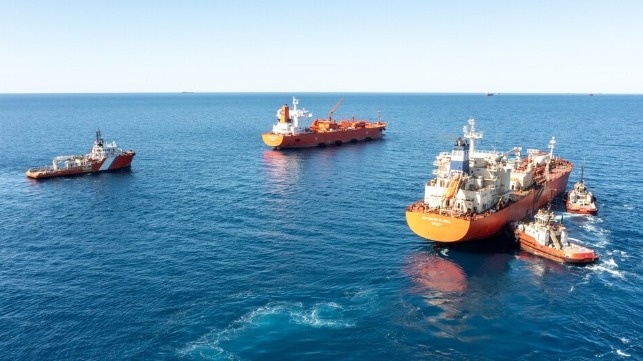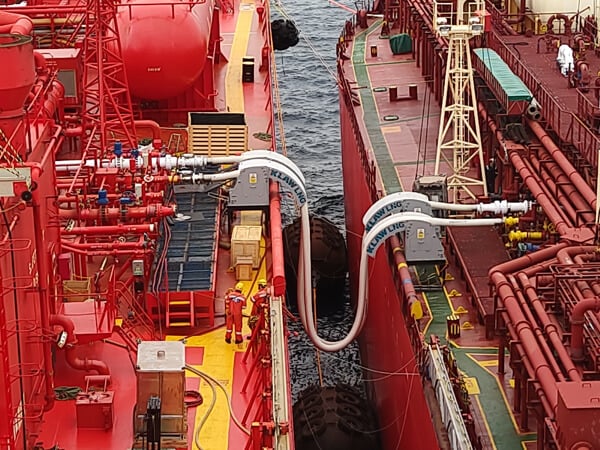First Ammonia STS Demonstrates Protocols for Ammonia Bunkering

As the next step toward developing industry competency to support ammonia bunkering, Singapore’s Global Centre for Maritime Decarbonisation (GCMD) led a first-of-its-kind ship-to-ship transfer of ammonia. The demonstration project was conducted in Australia’s Pilbara anchorage and to mimic future ammonia bunkering scenarios, the vessels were selected to be similar sizes to that expected for ammonia bunkering vessels.
Two transfers were conducted each requiring approximately six hours. In the absence of ammonia bunkering vessels and large, ammonia-fueled cargo ships, they worked to simulate a close proxy to test the essential steps that will be involved in vessel bunkering. To date, the only acknowledged ammonia bunkering operations were two conducted at a terminal in Singapore for Fortescue’s converted OSV, and recently NYK bunkered its ammonia-fueled tug in Japan using a truck-to-vessel method.
The vessels selected for the demonstration were Mitsui O.S.K. Lines (MOL) Green Pioneer, a 35,000 cbm ammonia carrier, and Navigator Gas’s Navigator Global, a 22,500 cbm ammonia carrier. Yara provided the ammonia used in the demonstrations and contributed its experience and knowledge on the safe handling of ammonia. Pilbara Ports also participated in the anticipation that the area would become an earlier provider to support the adoption of ammonia as a marine fuel and various Australian government agencies were involved.
The first transfer involved 4,000 cbm (approximately 2,700 tonnes) of ammonia from the Green Pioneer to the Navigator Global offshore at the Port of Dampier. The same ammonia cargo was then transferred back from the Navigator Global to the Green Pioneer.

Connection with special safety protocols for the first ammonia STS (GCMD)
According to the companies participating, the effort demonstrated the operational viability of ammonia bunkering.
Due to the toxicity of ammonia, extensive planning and precautions were incorporated into the project. They also incorporated additional safety mitigation measures. This included the use of emergency release couplings, emergency shutdown devices, and other safety equipment. After the ammonia transfer, they used hot gas and nitrogen purging procedures.
“This ammonia transfer pilot is a testament to the deliberate collaboration and rigorous planning of all parties involved. Beyond addressing the technical and operational challenges, executing this pilot required us to navigate complex commercial landscapes, including securing vessels and managing cargo transfer, as well as uncertainties and spur-of-the-moment hiccups that arise during operations,” said Professor Lynn Loo, CEO of GCMD. “This pilot marks a crucial step towards readying the ecosystem for using ammonia as a marine fuel, paving the way for eventual bunkering when ammonia-fueled vessels become available.”
GCMD has been leading several pilot projects to support the commercial development of alternative fuels. In preparation for the next phase of GCMD’s initiative to enable ammonia as a marine fuel, it says it will be leveraging the experience and knowledge gained from this pair of transfers to assess the feasibility of ammonia transfer elsewhere to ready other forward-looking ports for eventual ammonia bunkering.
